The Body Imperfect: Art as its Champion
“Our human frame, our gutted mansion, our enveloping sack of beef and ash is yet a glory. I hold a cracked mirror up to man.”
– Leonard Baskin, American Sculptor
The portrayal of the figure in art has existed for millennia, reaching a widening audience with each passing year. In more recent decades, the media—in forms of communication such as television, film, the internet, and the print industry– has also depicted the body. But often the body is in a flawless state, eliciting insecurity in its audience as a way to make a profit. Do these unattainable figures in the media extend to fine art, and does this in turn have an effect on real contemporary bodies? The question of whether art exerts undue pressure on the public to obtain and maintain utopian forms, as does a media fueled by enterprise, is a valid one. However, it seems that the art world embodies a higher, championing role. Art helps to assuage body anxieties and posits a challenge to an opportunistic media campaign that feeds on the vulnerability of the populace. Indeed, art gives the public a much-needed reprieve from the standards of physical excellence that no mortal can possibly reach.
The relentless societal pressure to be impossibly thin, coiffed, youthful, and made up, has prompted a highly charged, modern-day body anxiety. Women, to a greater extent, are under undue pressure to reach the physical ideal of the day. Images in the media put the pressure on its citizenry to fit a certain body mold, encouraged to spend hard-earned dollars in the process. By extension, the argument could be made that the fine art world, which caters to a population segment with deep pockets, would also be complicit in projecting idealized bodies within the figural art sphere. However, despite the lure of money swirling through galleries, auctions, fairs, and book deals, contemporary artists are resisting the urge to jump on the perfect body band wagon. In fact, artists provide a needed counterpart to its lure.
The 1950s
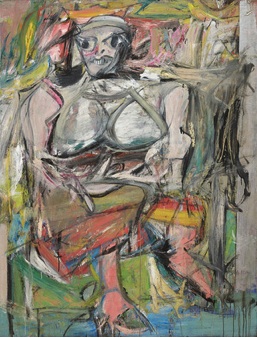
Beginning with the mid-century, when television dramatically increased its influence on body anxieties in the general population, the Abstract Expressionists were ratcheting up their brushstrokes and drips in New York. The mostly American, testosterone-laden group with their non-representational marks would seem to negate the body entirely, opting for motion over any figural emotion. This eschewing of the body could be seen as a rejection of it, or in another view, as a refusal to put undue emphasis on the corporeal.
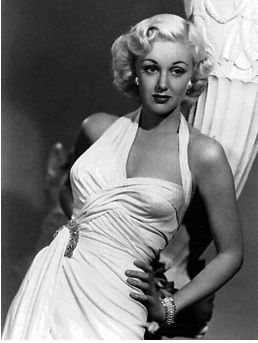
Painter Willem De Kooning, while part of the Abstract Expressionist movement, made a departure from it with his figurative paintings. With “Woman I” (1950-52), he selects a subject that’s been done before in art history–an idol, a Venus, or a nude. But in his version the idol is anything but goddess like. Said DeKooning, “I didn’t work on it with the idea of perfection, but to see how far one could go…how long you can stay on the stage with that imaginary audience.” (DeKooning and Sylvester, 46-7) To be sure, his ferocious, abstracted figure in “Woman I” (fig 1a) features slashes of energetic paint with bared teeth and barely recognizable features. The bright colors and shapes look collaged in areas, overlaid with additional gestural marks in charcoal, oil, and enamel paint. DeKooning’s work is certainly not as slick and pretty as the typical Hollywood publicity photograph, such as the image of 1950s film and TV actress Jane Sterling (fig 1b) would indicate, and hardly the idea of perfection.
The 1960s
The figure in fine art would become more popular as the painterly abstract brushwork of the Abstract Expressionists segued in to Pop Art, with its stylized realism of popular animate and inanimate icons. Artist Alex Katz would parallel the movement, his paintings and prints inspired by billboards, advertising, television, and the widescreen cinema of the day. (Katz) His individual style, featuring expanses of flat color, simplified shapes, and monochrome backgrounds would define his work, which still resonates today. “Red Smile” (1963) gives viewers a portrait of his wife Ada, who appears in much of his work. (Katz) Katz’ polished, calm execution provides a contrasting collage-like assembly of pale neutrals surrounded by Ada’s black hair, and vivid red background. The closely cropped image echoes the close up of a movie screen. Unlike the envy-inducing Hollywood views of celebrities, their images a panorama of unblemished skin, Alex Katz’ works convey an uncomplicated contentment. Katz’ paintings feel like a good relationship, reassuring viewers with a sense of well being.
The 1970s
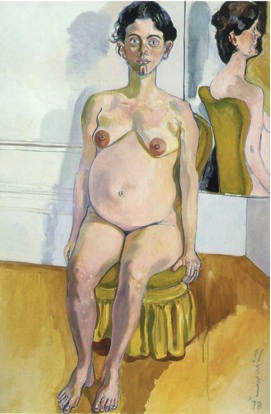
Alice Neel’s unromanticized, compassionate paintings focus on her human subjects as real people, rather than as paycheck prospects at the hands of Madison Avenue. Neel declared that her goal in painting was to portray the complete person within its era, less concerned with precise features. Neel is more concerned with identifying with her subject to the point of becoming the other person and thereby overcoming alienation. (Allara, 7) Known in part for her discerning nudes of pregnant women, Neel felt the need to portray pregnancy as a basic fact of life. Ancient artists proudly depicted this, but modern artists shy away, as if it were a block to a controlling male gaze. (Hills, 179-85) Neel’s portrait “Margaret Evans Pregnant” (1978) (fig. 2a) shows her friend seated on a garish yellow chair, directly at the center of the canvas, looking at the viewer with some apprehension. Her features are somewhat distorted, the skin on her legs a cooler color, indicating a lack of circulation. Her image is reflected in a mirror as an older version, a possible look to the future.
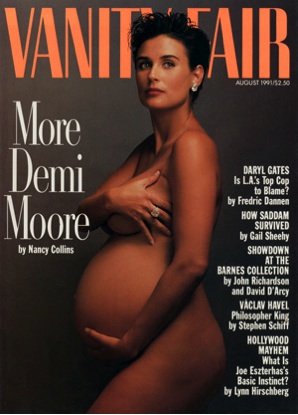
On the opposite end of the spectrum stands pregnant actress Demi Moore in the 1991 cover photo of Vanity Fair magazine. Moore is glamorously showcased in vein-free, stretch mark-free, fat-free glory. (fig.2b) To be sure, the image is ground-breaking in its daring to feature an unclothed expectant woman. But the air brushed photo, aided in its sexiness by a team of hair stylists and make up artists, not to mention the talents of photographer Annie Leibovitz, only has the effect of selling magazines while making pregnant women everywhere feel like swollen, mottled lumps. Unromanticized, Neel’s work goes beyond physicality to an understanding of her subjects. Unlike the alluring celebrities that grace the covers of magazines, the artist pays a more real homage to her painted models. With Neel, honesty in art is a privilege, bravery an easier goal on canvas where she can respect her subject’s struggle within a modern rat race.
The 1980s
While not a human figural artwork, Jeff Koons’ iconic 1986 piece, “Rabbit”, introduces the concept of sexuality, of breeding like a rabbit– a blow up inflatable animal cast in the cold industrial product of stainless steel. A large sculpture at 220 x 130 x 160 cm, “Rabbit” is from the artist’s Statuary series where he casts everyday objects, assisted by a team of artisans that he oversees. (Gioni, et al, 8) His creation has been likened to the Playboy bunny logo. The shiny metal serves as a mirror of the artist’s own egocentric nature, as well as that of a collective population, who crater to the seductive allure of the promise of sex and good looks. Koons has described this work as the “Great Masturbator”, making a public even more conscious of an innocent kind of body erotica. (Gioni, 8) Regardless of the work’s interpretation, it can be seen as a loveable sex toy of sorts, and Koons’ egotistical creations never threaten to mete out insecurities to his viewers. In fact his optimistic persona, as money-conscious as it is, has a feel-good aspect to it. Says Koons, “I wanted to make works that embrace everyone’s own cultural history and made everybody feel that their history was perfect just the way it was.” (Gioni, 8) His overblown artworks make his viewership bemused at his nostalgic kitsch, and comfortable in their skin.
The 1990s
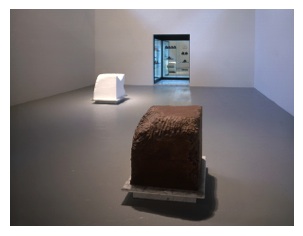
By the 1990s figural art took a more experiential direction for the viewer with the work of Janine Antoni. The artist’s portrayal of the body is created directly with her own body in her self-portrait “Gnaw” (1992) (fig. 3a), which features large, 600 pound cubes of chocolate and lard gnawed away by Antoni’s teeth. (Buskirk, 11,12) The unusual sculptural work also displays a candy box and lipsticks, made from the chewed chocolate and lard blocks, along with pigment and beeswax. Says Antoni, “I’m convinced the viewer won’t have an experience unless I’ve had an experience.” (Buskirk 11.12) Antoni uses her body to make art that elicits empathy for her labors.
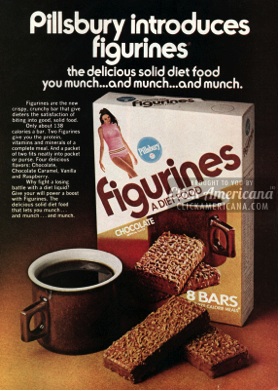
Juxtapose Antoni’s laborious chocolate work with a Madison Avenue advertisement presenting a chocolate diet product (fig. 4b), where Pillsbury promises the pictured svelte figure with every crunchy bite. Antoni’s art does not strike fear into real bodies to worry about their weight and self-image, but rather through her long process and thoughtful art increases an understanding of them.

Surely the obsession with physical perfection would be found in creations such as the specific body art of ORLAN, the French performance artist who has made her body her canvas through work such as repeated plastic surgeries, often in order to resemble art historical icons. But ORLAN has emphasized that ”the idea was to add and not take away, not to mutilate, but to do something that had never been done before and that was not recognized as increasing beauty.” (Bader, 91) ORLAN used implants on the sides of her forehead, her surgeon understanding that prettiness was not her aim. Instead, ORLAN used the surgical performance “to speak of the violence and pressure that is inflicted on women’s bodies”. (Bader, 59) In her performance art “Seventh Surgery: Performance Called Omnipresence” (1993), (fig. 4a), ORLAN is seen before, during, and after a graphic, appearance-altering surgical procedure staged in a bright green theatre.

The artist’s art speaks to the bodily pressures that women face, and contrasts with the plastic surgery advertisement (fig. 4b) that promises “new confidence”. Cosmetic surgery advertisements only intensify the pressure to look smooth, thin, pretty, and young. While her medium is often her own body, altered through plastic surgery, ORLAN does not use it to prompt a fear-based need in others to conform to unreasonable and popular standards of attractiveness. If anything, her looks oppose stylish trends.
Another artist who finds new ways to portray the figure while never using an entreating finger is Tim Hawkinson. His quirky figurative artworks are unique; the inventive artist always manages to intrigue. His art can reflect the human body through molds of parts of his body, inflatable blowups of his own image, sculptures of hyper magnified organs and digits, works that portray the human body from his own perspective, or how the body sees itself. True to the artist’s sensibility, which is adverse to modern-day vanity, this work often reflects what is unseeable in the reflection of a mirror. (O’Reilly, 164, 165) In his 1997 sculpture,”Bird”, Hawkinson uses his own body as a medium in his work. Although “Bird” represents an animal figure and not a human one, he incorporated his own fingernail clippings and super glue into a tiny 2 x 2 ¼ x 2 inch creation to give it a human element. (Howell, 51) The ephemeral, translucent bird looks sweetly peeved, with tiny raised arms and a skeletal form. When thinking of fingernails, one pictures a Madison Avenue nail polish ad, its models prosperous-looking, happy, and polished. But Hawkinson turns away from anything suggestive of the media. He is reticent to attach any meaning to his works, saying, “The physical construction is all I really present to viewers, and beyond that I like to leave it open. We all have our own experiences we bring to work.” (Howell, 51) He gives his viewer an unusual visual treat, and not an enticement to shiny bodily decoration.
The 2000s
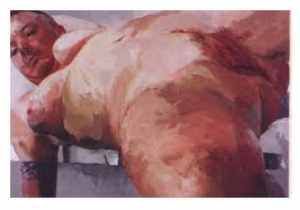
Figurative artist Jenny Saville emphasizes the formal aspects of gaining a more clinical view of the flesh through observing surgeries or reading forensic science books and visiting slaughterhouses. Saville goes on to say that she moves beyond this unromanticized process and looks for bodies and flesh that manifests contemporary times, a state of transitory nature such as a hermaphrodite or a half-dead head, more portraits of an idea or a feeling. (Schama, 124-29) Her 1999 oil painting “Matrix” (fig. 5a) exposes to the viewer the ample transgender body of Del La Grace Volcano, with female genitalia, breasts and decidedly male and mustached face. (Schama,
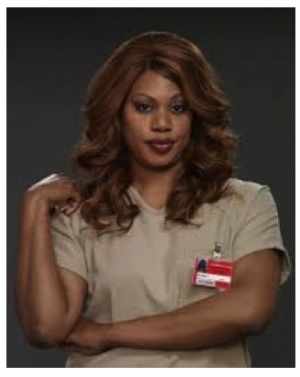
124-9) With Saville’s tackling of a transgender subject in all its closely cropped rawness, it would be rare that television would see such characters. Yet recent TV does, albeit in a notably attractive fashion, portrayed by openly transgender individuals such as Laverne Cox in the Netflix series Orange is the New Black. (fig 5b) Forward-thinking in prompting acceptance for transgender people, television nonetheless glamorizes characters such as Cox with flowing tresses, toned proportions, and full make up, even while her character resides in jail. (Nichols) To be sure, Cox’ appearance on television prompts a more accepting stance on sexual identity just through featuring such characters, but the pressure to look beautiful still comes through, equating femininity with stunning looks. Through the media, audiences see the sexy results that hormones, surgeries, and a team of beauty experts can bring. In contrast, Saville gives viewers a more direct and honest viewpoint, her massive, in-your-face paintings revealing the unclothed visceral reality that may shock but does not induce viewers to make an appointment at the beauty salon.
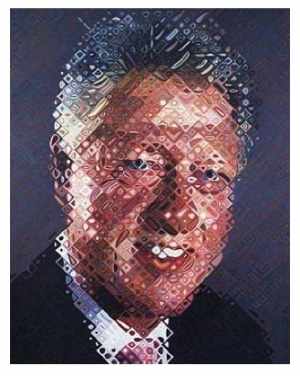
“William Jefferson Clinton”
2006 oil on canvas
9 x 7 ft
The artistic process and inner thoughts of artists such as Chuck Close, portrait painter extraordinaire, is evident in his massive, photography-based works. Divided into grids and overpainted in individual abstracted squares, they are powerful in their large impact. The artist is interested in the experience that the viewer has of looking at his work up close, where the face is unseen, thereby eliminating a finely rendered product to emulate as a personal model. Says Close, “I want to make the painting so big that from an average viewing distance you cannot see it as a whole. That forces you to read it—to go from the flat surface to the image and back to the flat surface to see the marks across it…so that you don’t even know what you’re looking at.” (Sooke) His mega 2005 portrait of former President Bill Clinton, “William Jefferson Clinton” (fig. 6a) speaks to this experience, his warts-and-all approach, and to his client’s larger than life persona, like the newspaper close-up in the NewYork Daily News of the President in office during his impeachment scandal. (fig. 6b) Close mused that he didn’t think the President would like his portrait, because when he saw the photographic study for it, he commented that he should have taken his water pills to eliminate the bags under his eyes. Says Close, “I find that stuff interesting because it’s the road map of your life.” (Sooke) In contrast to the photos in much of the print media, the artist prefers human-inspired irregularities to any photo-op kind of slickness.

Photographer Cindy Sherman’s work is a mixture of art history portrait and horror flick. The chameleon photographer’s choreographed self-portraits, where she dons the persona and attire of various female stereotypes, effectively challenges entrenched misogyny and ideals of beauty. (Hoban) Her piece, “Untitled 474” (2008) features a proud but pitied society woman who refuses to age gracefully. She is replete with over-arched penciled eyebrow, severely outlined lips that try to defy the effects of gravity, as well as breast implants, designer clothes, and bespoke background. “Untitled 474” points to the pressure to conform to a younger, more taut segment of society that threatens to eclipse an older generation. (Hoban) Compared to a Victoria’s Secret model such as Marissa Miller, Sherman’s subject is eclipsed by the six-packed, breast-augmented, bronzed fashion model. Yet Sherman’s socialite, through all her futile efforts and fakery, reads as humanly authentic.
Perhaps the figurative art of yesteryear, such as the Rubenesque beauties that graced many a panel, truly did reflect a 1600s bodily fashion trend in the population that was already in existence, at least in those who had enough wealth to eat well. Maybe the art itself prompted a certain figural look. Did Italian Renaissance men all look like the muscular, perfectly proportioned body of Michelangelo’s David? And if they did not, did they feel a pressurized need to conform to that standard? Perhaps these were merely reflections of what was considered beautiful, and humans like to look at representations of flawlessness that do not exist in real life. Maybe without the media as it exists today, that was idealization’s only agenda.
Or perhaps it is the media—hired by businesses that see an insecure, vulnerable public as a means to profits– that has stepped up the perfection expectation, hands outstretched for the mighty dollar. Celebrities play into the opportunistic scene as well, their glamorous images spread before a culture’s eyes, endorsing perfection and products alike. They, too, must feel the crush of image scrutiny to an even greater extent, as their livelihoods depend largely on their appearance. While the public bears some responsibility in standing up to the relentless pressure to possess a utopian body, without a pervasive media, unhealthy obsessions with the face and figure would be less extreme. With the merciless expectations of conventional beauty there is little complicity within the fine art world. The unconventionality and honesty of contemporary figurative artworks provide an antidote to the pain of bodily societal demands. In all its imperfection, the art world stands as the real body’s champion.
Works Cited
Allara, Pamela. “’Mater” of Fact: Alice Neel’s Pregnant Nudes.” American Art, Vol 8 (2), (Spring 1994): 7.
“Alex Katz.” The Art Story- Modern Art Insight, <,www.theartstory.org/artist-Katz-alex.htm> (July 6, 2015).
Bader, Joerg, et al. “ORLAN”, the Narrative. Milan, Italy: Charta, 2008.
Barrett, Terry. “Why is That Art? Aesthetics and Criticism of Contemporary Art”. Oxford: Oxford University Press, 2012.
Baskin, Leonard. “On the Nature of Originality,” Show (August, 1963): n.p.
Birnbaum, Daniel, et al. Defining Contemporary Art- 25 Years in 200 Pivotal Artworks. London: Phaidon Press Limited, 2011.
Buskirk, Martha. “The Contingent Object of Contemporary Art, A Sourcebook of Artists’ Writings.” Cambridge, Mass: The MIT Press, 2005.
Hesse-Biber, Sharlene. “Am I Thin Enough Yet? The Cult of Thinness and the Commercialization of Identity.” Oxford: Oxford University Press, 1996.
Hills, Patricia. Excerpts from an interview with Alice Neel in Hills, Alice Neel. New York: Harry N. Abrams, 1983.
Hoban, Phoebe. “The Cindy Sherman Effect” ArtNews, (February 14, 2012): 9:00 A.M. <www.Artnews.com/2012/02/14/the-Cindy-sherman-effect/> (July 6, 2015).
Howell, George. “As You Spend Time with it, A Conversation with Tim Hawkinson.” Sculpture, (April 2004): 51.
Nichols, James Michael. “Laverne Cox Named A Woman of the Year by Glamour Magazine,”
The Huffington Post, (November 5, 2014): < www.huffingtonpost.com 2014/11/05/LaverneCox-glamourmagazine_n_6109726.html> July 6, 2015).
Oral history interview with Alex Katz, 1969 Oct 20, Archive of American Art, Smithsonian Institution, oral-history-interviews-alex-katz-12448> July 8, 2015).
O’Reilly, Sally. “The Body in Contemporary Art.” New York: Thames and Hudson, 2009.
Richards, Judith Olch. “Inside the Studio- Two Decades of Talks with Artists in New York.” New York: Independent Curators International, 2004.
Schama, Simon. excerpts from “Interview with Jenny Saville” Jenny Saville. New York: Rizzoli, 2005.
Selz, Peter and Stiles, Kristine. “Theories and Documents of Contemporary Art- A Sourcebook of Artists’ Writings.” Berkeley, California: University of California Press, 2012.
Sooke, Alastair. “Chuck Close: Capturing the Clinton Charisma” The Telegraph (October 6, 2007) 12:01 A.M. BST www.telegraph.co.uk/culture/art/3668349/Chuck-Close-Capturing-the-Clinton-charisma.html (accessed July 6, 2015).
Sylvester, David.and DeKooning, Willem. Excerpts from “Content Is a Glimpse: Interview with David Sylvester,” Location, (New York) I (Spring 1963), 46-47.
Tim Hawkinson, ACE www.artseensoho.com/art/ACE/hawkinson99/h2.html (July 6, 2015).
What do you think? Leave a comment.











Nice writeup on the depictions of the human body.
The ideal of the perfect human body is a result of culture: religious functions, economy, advertisment, and other factors.
Agreed and as the saying goes, beauty is in the eye of the beholder. So anything goes. Unless it is a popularity content
Realism usually looks more smoothened out when it comes to human beings.
Great job on this post. I am curious as to the choices made for the works of art in each decade?
Why are the natural sculptures naked and the abstract ones not. Just a thought.
For a sculptor interested in naturalism and representing the beauty of the human body, it makes sense to scupt a nude. That way you can see and appreciate that beauty. For other artists interested in expressing other ideas and emotions, sculpting the details of the human form are less important. Of course, there are lots of examples of abstract sculptures of the human form that are nudes. The examples they chose for the videos just happened to be clothed.
While not all abstract are clothed I believe most of them are due to the artists ability to shape and create their vision while maintaining a somewhat realistic point of contrast.
They choose to have them sculpted naked because then you get see more of the body’s features more clearly.
Great article. In different cultures the human body is treated in varied ways as a means of cultural expression. Where people identify themselves as part of a select group through the use of particular skin decorations, hairstyles etc.
Because art is a means of communicating human experiences, human bodies are naturally depicted.
I think the arguments made in this article were intelligent and intriguing.
Amazing research for this article. Perceptions of bodies are, in my view, going to be key, in breaking down social stigmas and stereotypes. Why should our bodies determine so much of how we identify ourselves and are identified as by others?
The body is one of the oldest and most important subjects in art.
Great treatment of this topic.
Nowadays, we are not any more allowed to call something objectively beautiful, only “to me it is beautiful” or “I like it”, especially since art expresse the disorder and confusion of mankind.
The personified ideals of classical beauty have influenced art throughout the centuries until today!
Thanks for this trip through our history of figure art.
Thank you for great content.
What would a sculpture of the human body look like in the 22nd century?
The human figure has always been a common subject of the arts.
Religion is one of the most common reasons for the creation of figurative art.
Was. It was.
Nice description of art and it’s changing aspects
Major thankies for the article post.Really looking forward to read more. Really Great.
THis is a helpful article of art throughout the years and good use of sources as well
I think it’s difficult to compare art made for art’s sake with later examples of art in the media (like in TV shows or advertisements)… which in my opinion are clearly the embodiment of massively thought out boardrooms of “artistic” professionals. Anytime someone is trying to sell something, its meaning and its message are compromised.
Great article. I think the performance art of the 1960s and ’70s is really the beginning of a lot more critical thinking about the body, embodiment, subjectivity and so on. It was also (perhaps still is), in my opinion, the high-point of democratisation in art production because, well… everybody has a body.
And the Human is the greatest piece of art created. 🙂 So why not get inspired by it?
This made me excited to have a body.
Great article,human figures to have a perfect body.
Beauty is only skin, but once you pull back the different layers, that’s where you will see the true art.
While I agree that art can be called a champion of truth in body imaging over what we see in the media, there are countless artists who also depict the human body in ideal terms. Art is often an expression according to the views of the artist and the message they wish to convey or the discourse they wish to spark. The media intends to sell us something, but on the other hand, artists are geared toward expression and it not necessarily have to sell something visually appealing, because in the case of your examples, it is more about the ideas and notions artists can conjure with their subject matter.
Well written and a good description of the one of the more tangible values of art: communication of the truth. Advertisements have only a close fidelity to profit, whereas (if you are talented, driven, and lucky enough to make a living off of art) the artist can focus more on uncovering what is true in an increasingly complicated world.
Art as it, two ways channel- that viewers agency of cognition, interpretation and translation on the imagination and composition of perception by the artist. More it par, (to the intended and unintended collaterals) worth of the channels becomes a genuine communication.
‘In a society which profits from your insecurities, liking yourself is a rebellious act!’
A well-thought analysis of some of the tendencies during the past decades with regards to representation and body-image through art. I would love to see/read about even more examples and case studies!
Thankyou for such an informative article.
I like how you have highlighted the differences between art and mass media produced images.
I agree there is an ideology created to disenfranchise people and make money from insecurities.
However, some artists do break through. As you say Jenny Savilles paintings are honest and brutal reflecrions of the real harsh processes acting on bodies.
The challenge is getting the people that produce images in mass media to change representations so we can start to see more of ourselves and have less body anxiety.
Your critical mind is a brilliant tool. Thankyou for choosing to your thoughts.
Great thought-provoking article. I am not sure one can separate the media from the arts – they both reflect on each other. We live in a world obsessed with aesthetics. I look forward to a time when we are less obsessed with the way things look (especially felt by women and fuelled by the beauty industry) and rather pay attention to the way things are.
As a Professional Artist, and a Professional Actor, Fine Arts Business owner,and Arts Educator, with a Background Check, Figurative Arts; Portrait, Clothed or my favorite The Nude, has for centuries been a classic them for Artists and Art. I was born and raised in Seattle, Washington, 75 years ago this September. After High School graduation in June of 1965, that September, I entered the 5 year professional Fine Arts program of study. I was 18, and drawing and painting Nude Life Art models in 3 hour Studio classes. All our Nude models were Female, except for two Nude Male models. We needed more Nude men! I regret not being a Nude Male Life Art model while I was an Art Student. Drawing and Painting the Nude Human Figue, Male and Female Nudes, is more important to me as an Artist, than when I was 18 years old. There is a market for Fine Art Nudes. And I can always use Nude Art models, on line or in person. I live an hours drive West of Minneapolis/St. Paul, Minnesota. Michael Edwin Simmonds. Lester Prairie, Minnesota.